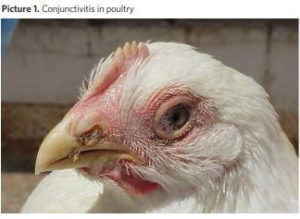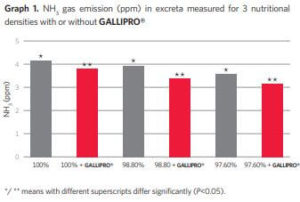
14 Jun GALLIPRO® can reduce ammonia emissions in broilers excreta fed with energy and protein reduced diets
Environmental foot print of the poultry production, a growing challenge. Over the past decades, the poultry sector’s growth and trends toward intensification and concentration have given rise to environmental concerns. A direct consequence of these structural changes is increased production of waste, which could result in environmental implications. An increase in waste by-products may correspondingly become an issue. Both local neighborhoods and the internal environment of production facilities can be affected. For example, an increase in ammonia levels can be detrimental for birds (conjunctivitis) (Picture 1) and workers in the farm (respiratory issues)

Can Bacillus based probiotics help to reduce gas emission?
The objective of this study was to evaluate the effect of a Bacillus[1]based probiotic Bacillus subtilis DSM17299 – GALLIPRO® (or GALLIPRO® Max in some markets) on ammonia emissions (NH3) in broiler excreta. Three different nutritional density formulations were compared. Each of them was compared with or without the use of GALLIPRO®. Eight hundred sixteen, 1-day-old Ross 308 broiler chicks were selected in a six-weeks feeding trial. Birds were randomly distributed to one of the six dietary treatments (8 replicate pens/ treatment with 17 birds/replicate pen). A factorial experimental design was used with three levels of metabolizable energy (ME) and crude protein (CP): 100% ME and CP (T1+T2), 98.8% ME and CP (T3+T4), and 97.6% ME and CP (T5+T6) with constant amino acid levels. Treatments 2, 4, and 6 were supplemented with 500 g/ton (1 lb./ton equivalent) of a Bacillus subtilis-based probiotic (Bacillus subtilis DSM17299 – GALLIPRO®), a target inclusion of 8×105 cfu/gram of feed. Experimental diets used were corn, wheat and soybean meal based.
- At the end of the trial, excreta samples were collected from each pen and stored in plastic boxes in duplicates.
- Fermentation took place for a period of five days at room temperature (25°C/ 77°F).
- Ammonia (NH3 ) emissions were measured with a Gastec (model GV-100) gas sampling pump (Gastec Corp., Kanagawa, Japan).
What can we expect?
A decreasing numerical trend (P=0.059) of NH3 gas emission from the excreta was observed for birds fed ME- and CP-reduced diets compared with control diets. Birds fed the GALLIPRO® probiotic supplemented diets showed significantly reduced NH3 emissions (P<0.05) compared to those fed diets without the probiotic

Summary of results
Supplementation of GALLIPRO® in broiler diets during a period of 6 weeks allows significant reduction of ammonia emissions (NH3 ) compared with non-supplemented diets, regardless of nutrient concentration. This effect can be explained by 2 major benefits.
- Protection of the top of the villi (GALLIPRO® creates micro[1]colonies in the gut) prolongs and protects this very important location for intestinal absorption
- By releasing enzymes locally, close to the brush broth, GALLIPRO® improves the availability of indigestible nutrients like complex proteins and carbohydrates, thus improving the digestibility of these key elements of the feed.
GALLIPRO® impacts positively the carbon foot print as well as animal and human wellbeing.
The benefits of including GALLIPRO® in broiler rations allow for reduced ammonia emissions (NH3) in their excreta.
It is well known that GALLIPRO® has the ability to colonize the top of the intestinal villi with two major benefits to the bird’s intestine (Konieczka et al. 2018): protection of villi and releasing different substances. These 2 mechanisms lead to better use of nutrients by birds. There is less non – digested waste excreted by bird. This result in double benefit: less nutrients is wasted (excreted), and less nutrients leftovers (like non digested protein) for the pathogenic bacteria growth are available.
Reducing this waste not only makes an economical impact on animal production (more nutrients available for birds to grow), but also allows to reduce gas emission. This can impact the environment, as well as birds and human (farm workers) welfare.




Sorry, the comment form is closed at this time.